 W
WThe Albany Charter half dollar, also known as the Albany-Dongan half dollar or Albany half dollar, is a commemorative half dollar struck by the United States Bureau of the Mint in 1936. It was designed by sculptor Gertrude K. Lathrop, who lived in Albany, New York's state capital.
 W
WAnimals in Pools is a series of fountains and bronze sculptures of Pacific Northwest animals, designed by American artist Georgia Gerber and located in Portland, Oregon, in the United States. The series was installed in 1986 as part of the renovations associated with construction of the MAX Light Rail. Funded by the Downtown Merchants Local Improvement District, TriMet and the United States Department of Transportation, the sculptures were presented as gifts to the city and remain part of the collection of the City of Portland and Multnomah County Public Art Collection courtesy of the Regional Arts & Culture Council.
 W
WThe Animals in War Memorial is a war memorial, in Hyde Park, London, commemorating the countless animals that have served and died under British military command throughout history. It was designed by English sculptor David Backhouse and unveiled in November 2004 by Anne, Princess Royal.
 W
WAustralian Seal is an outdoor sculpture of 1968–69 by Thomas Bass, installed outside the Embassy of Australia, Washington, D.C., in the United States. The bronze sculpture measures approximately 8 feet (2.4 m) x 5 feet (1.5 m) x 2 feet (0.61 m) and is set on a flagstone base. It depicts a kangaroo, emu, and the Australian shield, which includes images of St. George's Cross, Queen Victoria's crown, a Maltese Cross, magpie, black swan, and lions. Above the shield is a seven-pointed star.
 W
WBremen Town Musicians is a public art work by artist Gerhard Marcks located at the Lynden Sculpture Garden near Milwaukee, Wisconsin. The bronze sculpture is based on the fairytale by the Brothers Grimm; it is installed on the garden's lawn.
 W
WCapitol Beaver Family is a 1985 bronze sculpture depicting three beavers by artist Kenneth M. Scott, installed outside the Oregon State Capitol, in Salem, Oregon, United States. It was donated by the Willamette Christmas Association.
 W
WClara the rhinoceros was a female Indian rhinoceros who became famous during 17 years of touring Europe in the mid-18th century. She arrived in Europe in Rotterdam in 1741, becoming the fifth living rhinoceros to be seen in Europe in modern times since Dürer's Rhinoceros in 1515. After tours through towns in the Dutch Republic, the Holy Roman Empire, Switzerland, the Polish–Lithuanian Commonwealth, France, the Kingdom of the Two Sicilies, the Papal States, Bohemia and Denmark, she died in Lambeth, England.
 W
WConnect is a public art work by artist Jeremy Wolf. It is installed in Riverside Park on the east side of Milwaukee, Wisconsin.
 W
WA statue of a donkey, sometimes called Democratic Donkey, is installed outside Boston's Old City Hall, in the U.S. state of Massachusetts. Roger Webb acquired the bronze sculpture in Florence, Italy. It was installed outside Old City Hall in 1998.
 W
WA Donkey, 3 Rocks, and a Bird., also known as Donkey, Bird and Rocks and Donkey, Three Rocks, and a Bird, is an outdoor 1992 sculpture by Brad Rude, installed at Catlin Gabel School in West Haven-Sylvan, a census-designated place in Washington County and the Portland metropolitan area, in the U.S. state of Oregon.
 W
WDürer's Rhinoceros is the name commonly given to a woodcut executed by German painter and printmaker Albrecht Dürer in 1515. The image is based on a written description and brief sketch by an unknown artist of an Indian rhinoceros that had arrived in Lisbon in 1515. Dürer never saw the actual rhinoceros, which was the first living example seen in Europe since Roman times. In late 1515, the King of Portugal, Manuel I, sent the animal as a gift for Pope Leo X, but it died in a shipwreck off the coast of Italy in early 1516. A live rhinoceros was not seen again in Europe until a second specimen, named Abada, arrived from India at the court of Sebastian of Portugal in 1577, being later inherited by Philip II of Spain around 1580.
 W
WEntry of Christ into Jerusalem is a 1617 oil painting by Flemish artist Anthony van Dyck, located in the Indianapolis Museum of Art, which is in Indianapolis, Indiana. It depicts Jesus entering Jerusalem as described in the Gospels, the event celebrated on Palm Sunday.
 W
WFate of the Animals is a painting by Franz Marc created in 1913. It is oil on canvas. This work contrasts most of Marc's other works by presenting animals in a brutal way rather than depicting them in a peaceful manner. Marc's strong ties with animals as his subjects remains uncertain, but it is predicted to stem from his childhood dog. Fate of the Animals remains one of Marc's most famous pieces and displays Der Blaue Reiter style that he co-founded with Wassily Kandinsky. The painting currently resides in the Kunstmuseum in Basel, Switzerland.
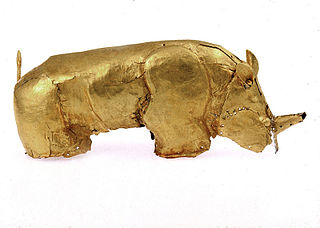 W
WThe golden rhinoceros of Mapungubwe is a medieval artifact made from wood which is covered in thin sheets of gold from the medieval Kingdom of Mapungubwe, which is located in modern-day South Africa. It was found on a royal grave on Mapungubwe Hill in 1932 by archaeologists from the University of Pretoria. The artifact is described as being "small enough to stand in the palm of your hand."
 W
WGuardians of the Gate is a 1991 Everdur bronze sculpture depicting a family of sea lions by Miles Metzger, located northwest of Pier 39 and adjacent to the Embarcadero Center in San Francisco, California, United States. The sculpture was dedicated on January 22, 1992, and was surveyed by the Smithsonian Institution's Save Outdoor Sculpture! program the same year. It is administered by Pier 39 Limited Partnership Beach Street and the Embarcadero Center.
 W
WHead of a Walrus is a 1521 pen drawing painted in watercolour by the German artist Albrecht Dürer, now in the British Museum, London. At the time the walrus' main European population was around Scandinavia, and they were exotic to inland Europeans. The work reflects Dürer fascination with what he perceived as unusual animals, with similarly intentioned works including depictions of lions and rhinoceros. The drawing created as part of a larger series of 167 drawings of quadrupeds.
 W
WThe Hippopotamus and Crocodile Hunt is an oil painting on canvas by Peter Paul Rubens. It was commissioned in 1615 to decorate Schleißheim Palace, along with three other works depicting lion, wolf, and boar hunts. The cycle of paintings were looted from the palace during the Napoleonic Wars. Only the Hippopotamus and Crocodile Hunt was returned to Munich, at which time it was added to the collection that is now the Alte Pinakothek.
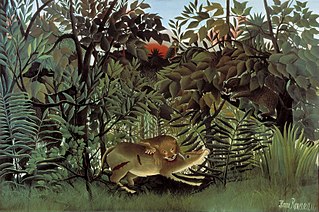 W
WThe Hungry Lion Throws Itself on the Antelope is a large oil-on-canvas painting created by Henri Rousseau in 1905. Following Scouts Attacked by a Tiger the previous year, The Hungry Lion was the second jungle painting to mark Rousseau's return to this genre after a 10-year hiatus caused by the generally negative reception to his 1891 painting Tiger in a Tropical Storm.
 W
WThe Hunters Palette or Lion Hunt Palette is a circa 3100 BCE cosmetic palette from the Naqada III period of late prehistoric Egypt. The palette is broken: part is held by the British Museum and part is in the collection of the Louvre.
 W
WA statue of King Kong by Nicholas Monro was commissioned in 1972 for display in Manzoni Gardens in The Bull Ring, in the centre of Birmingham, England. It was later displayed elsewhere in Birmingham, then at markets in Edinburgh, Penrith, at the Henry Moore Institute in Leeds, and now in the owner's garden in Cumbria.
 W
WThe Kongouro from New Holland is an oil painting by George Stubbs. Depicting a kangaroo, it is the first depiction of an Australian animal in Western Art, along with a painting of a dingo—Portrait of a Large Dog—also by George Stubbs. It is part of the collection of the National Maritime Museum in Greenwich, London. The work was commissioned by Joseph Banks and based on the inflated skin of an animal he had collected from the east coast of Australia in 1770 during Lieutenant James Cook's first voyage of discovery. It also seems to be based on Sydney Parkinson's drawing of a kangaroo; Parkinson was James Cook's illustrator on the first voyage. It depicts the animal sitting on a rock and looking over its shoulder with a backdrop of trees and mountains. The two were the only two paintings that Stubbs did not draw from a live subject.
 W
WThe Lady with an Ermine is a portrait painting widely attributed to the Italian Renaissance artist Leonardo da Vinci. Dated to c. 1489–1491, the work is painted in oils on a panel of walnut wood. Its subject is Cecilia Gallerani, a mistress of Ludovico Sforza, Duke of Milan; Leonardo was painter to the Sforza court in Milan at the time of its execution. It is the second of only four surviving portraits of women painted by Leonardo, the others being Ginevra de' Benci, La Belle Ferronnière and the Mona Lisa.
 W
WLoosey the Moose is a sculpture of a moose in Park City, Utah, United States.
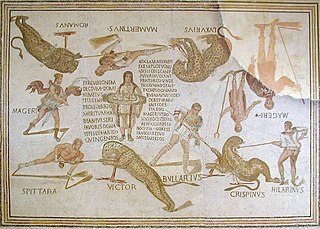 W
WThe Magerius Mosaic is a 3rd-century Roman mosaic discovered in 1966 in the Tunisian village of Smirat and presently displayed in the Sousse Archaeological Museum. The mosaic presumably decorated a country villa belonging to a man named Magerius.
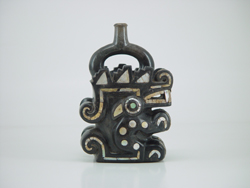 W
WThe Moche Crawling Feline is a specific stirrup spout vessel dating from 100—800 CE. This Moche ceramic effigy is currently in the collection of Larco Museum, in Lima, Peru. It comes from the North Coast of Peru. It represents a zoomorphic character: a lunar dog, or a crawling feline.
 W
WThe "Nightmare Elk" was a metal sculpture of an elk, temporarily installed in Portland, Oregon.
 W
WA Parade of Animals, or Parade of Animals, is an outdoor bronze sculpture series by Peter Helzer, installed in Willson Park, on the Oregon State Capitol grounds, in Salem, Oregon, United States.
 W
WThe Responsibility of Raising a Child, also known as From the Mad River to the Little Salmon River, or The Responsibility of Raising a Child, is an outdoor 2004 bronze sculpture by Native American artist Rick Bartow, located in Portland, Oregon, United States.
 W
WRhinocéros is a 1878 sculpture by Henri Alfred Jacquemart; a life-sized depiction of a rhinoceros in cast iron. Commissioned to stand outside the Trocadéro Palace for the 1878 Exposition Universelle, it was completed quickly to be ready in time for the opening of the fair. Well received at the time, it was moved in 1935 to allow for the remodelling of the palace and grounds for the 1937 Exposition Internationale des Arts et Techniques dans la Vie Moderne. The sculpture was sited near to the Porte de Saint-Cloud before being acquired by the Musée d'Orsay in 1985. It now stands in the esplanade in front of the museum, with two other animal statues from the 1878 exposition.
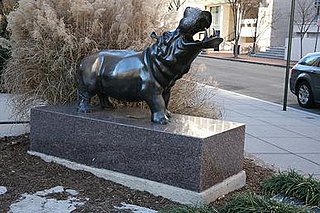 W
WThe River Horse is a bronze sculpture of a hippopotamus located on the campus of George Washington University. It is in front of Lisner Auditorium, at 21st Street and H Street, Northwest, Washington, D.C., in the Foggy Bottom neighborhood.
 W
WSt. Francis in Ecstasy is a painting by Italian Renaissance master Giovanni Bellini, started in 1475 and completed around 1480. Bellini depicted the religious figure of St. Francis of Assisi in the landscape. In 1852, the painting was listed on June 19th at Christie's. It was part of the 1857 Manchester Art Treasures exhibition. In 1915, Henry Clay Frick bought the painting for $170,000, and it remains in the Frick Collection, in New York City.
 W
WVictoria Centennial Fountain, also known as Back Fountain or simply Centennial Fountain, is installed outside the British Columbia Parliament Buildings in Victoria, British Columbia. The fountain was designed by Robert Savery in 1962, and commemorates the four colonies and territories that formed British Columbia. The bronze sculptures of a bear, eagle, gull, sea otter, raven, and wolf represent the province's geography and history.
 W
WVision after the Sermon is an oil painting by French artist Paul Gauguin, completed in 1888. It is now in the Scottish National Gallery, Edinburgh. It depicts a scene from the Bible in which Jacob wrestles an angel. It depicts this indirectly, through a vision that the women depicted see after a sermon in church. It was painted in Pont-Aven, Brittany, France.
 W
WThe Vision of Saint Eustace is a painting by the early Italian Renaissance master Pisanello, now in the National Gallery in London. The date of the work is unknown and has been assigned by various scholars to different points in Pisanello's career, but the National Gallery's website currently dates it to "about 1438-1442".
 W
WWe Have Always Lived Here is a 2015 public art installation by Greg A. Robinson, installed at Tilikum Crossing in Portland, Oregon, in the United States. The work consists of two traditional Chinook basalt carvings sited at both ends of the bridge, plus a bronze medallion on the northeast side of the bridge.
 W
W"William", also known as "William the Hippo", is an Egyptian faience hippopotamus statuette from the Middle Kingdom, now in the collection of the Metropolitan Museum of Art in New York City, where it serves as an informal mascot of the museum. Found in a shaft associated with the Upper Egyptian tomb chapel of "The Steward, Senbi", in what is now Meir, William dates from c. 1961 BC – c. 1878 BC, during the reigns of Senusret I and Senusret II. This 20 cm figurine in Egyptian faience, a clay-less material, has become popular not only for his endearing appearance, but also because his defining characteristics illustrate many of the most salient facets of craft production in ancient Egypt during this time.
 W
WWisconsin is a statue on top of the Wisconsin Capitol Building created by Daniel Chester French.
 W
WThe Wisconsin Territorial Centennial half dollar was designed by David Parsons and Benjamin Hawkins and minted in 1936. The obverse depicts a badger and the territorial seal, while the reverse shows a pick axe and lead ore.
 W
WThe Wolverine pendant of Les Eyzies is a bone pendant decorated with an engraved drawing of a wolverine, probably from the cave of Les Eyzies, Dordogne, France. The pendant is from the late Magdalenian period and around 12,500 years old. It now forms part of the Christy Collection in the British Museum, where it is normally on display in Room 2. Between 7 February - 26 May 2013 it was displayed in the exhibition at the British Museum Ice Age Art: Arrival of the Modern Mind
 W
WZhong Kui the Demon Queller with Five Bats is a popular Chinese painting featuring the Chinese mythological spirit Zhong Kui. It originates from the Ming dynasty (1368–1644). A possible painter for this artwork is Wu Wei. The painting is held in the Ashmolean Museum in England.